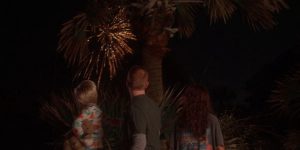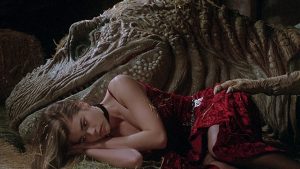
“Oh baby, you are so talented,” exclaims Bart (Cleavon Little), the wily protagonist of Blazing Saddles. The first Black sheriff in the Old West town of Rock Ridge, Bart had to escape the genteel, devout, and very racist citizens by pulling a gun on himself and pretending that he is both his own captor and hostage. The ruse works, leading to Bart’s self-praise into the camera… he also acknowledges “they are so dumb.”
Bart’s broad shenanigans match not only the stupidity of the townspeople but also the tone of the Mel Brooks classic. Written by Brooks and a host of co-writers (including an uncredited Richard Pryor), Blazing Saddles combines Looney Tunes humor with biting social commentary, and a genuine love of the Hollywood Western, making for a movie at once eternal and immediate.
Little, Brooks, and all the writers contributed to the success of Blazing Saddles. But holding the whole thing together was a comic genius, who excelled at playing calmness amid chaos. We’re talking about Gene Wilder as none other than the Waco Kid.
The Calmest Hand in the West
Gene Wilder enters Blazing Saddles in an appropriately wacky scene. After Bart again breaks the fourth wall to tell the audience about the “drunk in cell two,” we see Waco hanging upside down. Wilder’s cherubic face is unshaven and his curly locks dangling.
“Are we awake?” asks Bart, fully aware of the ridiculous sight. “Are we Black?” responds the Kid. When Bart answers in the affirmative, the Kid continues. “We’re awake. But we’re very puzzled.”
The exchange falls in line with the absurdity of the movie, and its both cartoonish and satirical aspects. It also shows off Wilder’s comic skills, which is the secret ingredient that makes Blazing Saddles an enduring classic.
Wilder delivers his lines with an unbothered drawl, a gentleness that acknowledges the strangeness of his situation but doesn’t go too broad or silly. Wilder doesn’t compete with Little for the screen. Rather he takes the gags as they come to him, leaving space for Little to go broad with Bart.
Just before Bart’s battle with the bestial Mongo (Alex Karras), one of the most looney sections of the film, the Kid shaves and chats with the sheriff. The scene serves to establish the connection between the two. Bart laughs through his frustration at the bigotry of the people of Rock Ridge and encourages the Kid to get back on the wagon as he’s drying out. But before anything can get too sincere, we’re reminded that this is a Mel Brooks movie, which means we must not go more than two minutes without a joke (this is not a complaint, to be clear). So the conversation has a gag in the middle, in which Bart hands the Kid a joint.
“Listen, Bart,” he says, his voice in a high falsetto before dropping back to its normal tone. Despite the funny voice, Wilder never drops the Kid’s look of concern for Bart from his face. He plays the scene straight and lets the gag stand for itself.
When Bart reunites with his friends, the Kid hangs back as they celebrate, at least until a group of baddies descend upon them. Even then, Wilder keeps a straight face when disarming the villains, letting everyone else celebrate the joke about his preposterous speed.
In retrospect it’s fascinating to remember Gene Wilder was not Mel Brooks’s first choice for Jim, the alcoholic formerly known as the Waco Kid. Initially, Brooks offered the part to John Wayne, who rejected the script on the grounds of its blueness (though he claimed to have loved reading it). Brooks eventually cast Academy Award-winner Gig Young as the Kid. But Young’s alcoholism made him collapse on the first day of shooting, and Brooks fired him.
In a pinch, Brooks turned to Wilder, with whom he had worked on The Producers. Brooks had Wilder in mind for Blazing Saddles villain Hedley Lamarr, which eventually went to Harvey Korman. But it’s hard to see anyone but Wilder in the part, exactly because of his relaxed screen presence.
Shooting With the Right Hand
Nothing demonstrates Wilder’s skills like a conversation between the Waco Kid and Bart, early into their friendship. Over a game of chess, the Kid reveals his identity as a legendary gunslinger, only to be met with skepticism from Bart.
“If you’re the Kid, then show me something,” the sheriff challenges.
“Well, maybe a couple of years ago I could show you something, but today…,” answers the Kid. To demonstrate his point, he lifts his right hand, which holds still.
“Steady as a rock,” says the supportive Bart, ignoring the despairing way that the Kid stares at his unmoving arm.
“Yeah,” returns the Kid, lifting his left hand which shudders with delirious tremors. “But I shoot with this hand!” Wilder realizes that the joke stands on its own, and he doesn’t need to do anything to sell it. If he were to break the fourth wall or emphasize the punchline, as most Brooks actors do, it would distract from the hilarious bit.
He continues with the exact same earnest seriousness that one would find in the Westerns that so inspired Brooks. The Kid talks about his unhappy reign as the fastest gun in the world. “Well, it got so that every piss-ant prairie punk who thought he could shoot a gun would ride into town to try out the Waco Kid,” he laments. “I must have killed more men than Cecil B. DeMille.”
Wilder doesn’t underscore the DeMille crack, nor does he oversell the pathos of his character. Instead he delivers the lines exactly like a proper Western hero. He only allows a slight bit of exaggeration when he describes the moment when a six-year-old kid challenged him. “Well, I just threw my guns down and walked away,” he says with an even voice, before increasing to a slight scream to say, “The little bastard shot me in the ass!”
That scene from Blazing Saddles shows why Wilder made for such a powerful comedic presence, not just in other Brooks films, such as Young Frankenstein, but also in his Pryor collaborations Stir Crazy and See No Evil, Hear No Evil, and especially in Willy Wonka and the Chocolate Factory.
Wilder’s talent is not just in making fantastic jokes, but also in making space for others to be so talented, no matter how chaotic the surroundings.
The post The Gene Wilder Scene in Blazing Saddles That Speaks to His Genius appeared first on Den of Geek.





